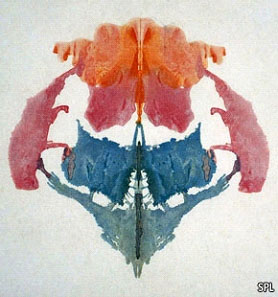『重新认识一种古老的心理学测试方法。』
The Rorschach test: A few blots in the copybook
罗夏墨迹测试:习字本上的几滴墨水
Nov 12, 2011 | From The Economist

IT SOUNDS like voodoo. But the Rorschach test, in which elements of someone’s personality can be deduced, its proponents claim, by his description of what he sees in a series of inkblots, has been used for 90 years, and is still going strong.
The original test was devised by Hermann Rorschach, a Swiss psychiatrist, in 1921. It involved someone (usually a psychologist or psychiatrist) asking someone else to look at ten inkblot images. In each case, the interlocutor inquires of the viewer, “What might this be?”, notes the response and attempts to draw conclusions.
The question has always been, of course, how reliable the connection is between the response to the blots (generally, people, animals or objects) and the alleged diagnosis. Over the years, many experiments have been done to test the link. Now Gregory Meyer of the University of Toledo and his colleagues have reviewed the data. Their results, which form the basis of a new manual on the topic, suggest the inkblot test does have real power. But Dr Meyer also rejects some of the traditional claims made on its behalf.
Dr Meyer’s study is a review of 1,292 papers that report experimental attempts to link Rorschach responses with personality traits that have been established by other means. His main conclusion is that some of the ways the test has been used are, indeed, useless. He proposes, for example, axing the alleged connection between reporting mirrored images in a blot and the viewer’s level of egocentricity. He would also get rid of the idea that if a viewer focuses on the details of an image rather than the broader picture, then he is likely to have an obsessive personality. A third traditional interpretation that does not pass muster, in Dr Meyer’s view, is the suggestion that when a viewer sees things in a blot that the examiner thinks do not resemble the blot, that indicates impaired perception, which can lead to a diagnosis of psychosis. Dr Meyer would not get rid of this altogether. But he thinks the idea needs to be recalibrated.
Some Rorschach diagnoses do seem to stand up, though. People who report seeing representations of passivity or helplessness in the blots are thought to have a dependent personality, meaning they rely on others to satisfy their needs. Some of the studies Dr Meyer looked at did indeed find that people who produce such responses are more likely to request guidance in a classroom, ask an experimenter for help when solving puzzles, or hold on to a guide when they are blindfolded. And responses in which a viewer synthesises several elements in an inkblot to show how they are interrelated do seem to be correlated with intellect; such responses are found most often in people who also score highly on an unrelated psychological assessment, the Wechsler Adult Intelligence Scale.
Dr Meyer disposes, too, of one perennial criticism of the Rorschach test—that it is culture-dependent. Studies in numerous countries come to broadly the same conclusions. A qualified thumbs-up, then, for inkblots. Perhaps the biggest threat to the test is that no one uses fountain pens any more, and so inkblots themselves have more or less become things of the past.
热门推荐:
考研网校哪个好
新东方考研培训班
考研培训班
考研培训机构哪个好
考研英语网络课程
文都考研网校
北京考研培训班

